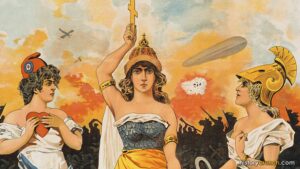The Women’s Suffrage Movement in the United States was the struggle for the right of women to vote and participate equally in the political process. It occurred from the mid-19th century to the early 20th century and involved periods of activism and famous leaders who dedicated their lives to achieving gender equality. As a historical event, the movement took place throughout periods of industrialization in the United States, the Gilded Age and the Progressive Era. This article explores the history of the Women’s Suffrage Movement in the United States including significant events and people.
WHAT LED TO THE WOMEN’S SUFFRAGE MOVEMENT IN THE UNITED STATES?
As stated above, the Women’s Suffrage Movement in the United States had its beginnings in the early 19th century. This was when activists began advocating for broader women’s rights, including the right to vote. Historians generally argue that the calls for women’s rights emerged alongside other rights movements.
For example, the Abolitionist Movement, which sought to end slavery, played a crucial role in the emergence of the women’s suffrage movement. Many early women’s rights activists were also involved in the abolitionist cause. The experience of advocating for the rights of enslaved people helped these women develop organizational skills and political strategies, and it also made them more aware of their own lack of rights.
As well, the events of the Industrial Revolution also had a profound impact on women’s roles in society in the 19th century. As the economy shifted from agrarian to industrial, more women began working in factories and other industrial jobs. This increased economic participation highlighted the need for women to have a say in the political decisions that affected their lives and working conditions. As a result, this helped lead to the women’s rights movement.
Furthermore, one of the first significant events in the movement was the Seneca Falls Convention in 1848. Organized by Elizabeth Cady Stanton and Lucretia Mott, this convention brought together like-minded individuals to discuss the social, civil, and religious condition and rights of women. The convention produced the Declaration of Sentiments, a document modeled after the Declaration of Independence, which called for equal rights for women, including the right to vote. As such, historians consider the Seneca Falls Convention to be the formal beginning of the women’s suffrage movement in the United States.
As well, it should be noted that the fight for women’s rights was occurring at roughly the same time across many different countries. For instance, Britain and Canada also experienced their suffrage movements in the 19th century and early 20th century.
IMPORTANT PEOPLE OF THE WOMEN’S SUFFRAGE MOVEMENT IN THE UNITED STATES
The Women’s Suffrage Movement in the United States was led by several significant people. For example, Susan B. Anthony and Elizabeth Cady Stanton were two of the most prominent leaders of the Women’s Suffrage Movement. Together, they founded the National Woman Suffrage Association (NWSA) in 1869, which focused on advocating for a constitutional amendment to grant women the right to vote. Their partnership and relentless campaigning were instrumental in advancing the cause of women’s suffrage in America.
African American women also played crucial roles in the suffrage movement. For instance, Sojourner Truth, a former slave turned abolitionist and women’s rights activist, is well-known for her powerful speech, “Ain’t I a Woman?” delivered at the Ohio Women’s Rights Convention in 1851. Her advocacy highlighted the fight for rights based on both race and gender in America.
CHALLENGES AND OPPOSITION TO THE WOMEN’S SUFFRAGE MOVEMENT
The Women’s Suffrage Movement faced significant opposition from various social and political groups. Many argued that women’s involvement in politics would disrupt social norms and family structures. Others believed that women lacked the capacity to make informed political decisions. Many of these views were based on dated views of the traditional roles for men and women in society. Despite these challenges, suffragists continued to organize, protest, and educate the public about the importance of women’s voting rights.
The movement also experienced internal divisions over strategy and goals. For instance, the National Woman Suffrage Association (NWSA), led by Susan B. Anthony and Elizabeth Cady Stanton, focused on a federal amendment for women’s suffrage, while the American Woman Suffrage Association (AWSA), led by Lucy Stone, pursued a state-by-state approach. This split temporarily weakened the movement, but both organizations ultimately contributed to the overall success of the cause.
MAJOR EVENTS IN THE WOMEN’S SUFFRAGE MOVEMENT IN THE UNITED STATES
The fight for equal voting rights in the United States unfolded as a series of major events and significant milestones. For example, in 1890, the National Woman Suffrage Association (NWSA) and American Woman Suffrage Association (AWSA) merged to form the National American Woman Suffrage Association (NAWSA). This unification strengthened the movement and allowed for more coordinated efforts towards equal voting rights. Under the leadership of figures like Carrie Chapman Catt, NAWSA used both state-level campaigns and lobbying for a federal amendment.
Next, the Women’s Christian Temperance Union (WCTU), led by Frances Willard, also played a significant role in the suffrage movement in the United States. In fact, the WCTU’s advocacy for ‘temperance’ (the movement to prohibit alcohol) was closely linked to women’s suffrage, as many believed that women voters would support social reforms, including temperance laws.
As well, Alice Paul and Lucy Burns, who formed the National Woman’s Party (NWP) in 1916, introduced more radical tactics to the suffrage movement. They organized the Silent Sentinels, a group of women who picketed the White House demanding voting rights. These women faced arrests, imprisonment, and harsh treatment, but their perseverance drew national attention to the suffrage cause.
World War I, which occurred from 1914 until 1918, played a crucial role in changing public attitudes toward women’s suffrage. The United States joined the fighting of World War I in 1917, and fought on the side of the Allied Powers of Britain and France. The homefront of World War I underwent several dramatic changes during this time, including the roles of women in American society. For instance, as American women took on roles traditionally held by men, who were away fighting, their contributions to the war effort demonstrated their capability and strengthened the argument for their right to vote.
Ultimately, this all led to the passage of the 19th Amendment to the United States Constitution. On June 4th, 1919, Congress passed the amendment, and on August 18th, 1920, Tennessee became the 36th state to ratify it, securing the necessary majority for it to become law. The 19th Amendment prohibited any United States citizen from being denied the right to vote on the basis of sex, marking a significant victory for the Women’s Suffrage Movement.
IMPACTS OF THE WOMEN’S SUFFRAGE MOVEMENT IN THE UNITED STATES
The ratification of the 19th Amendment had profound political and social impacts in the United States. First, it allowed millions of women to participate in the democratic process and influence public policy. The success of the suffrage movement also paved the way for future civil rights movements, demonstrating the power of organized activism and the importance of perseverance in the fight for equality.
While the 19th Amendment was a significant milestone, the fight for gender equality continued. More specifically, many women, particularly women of color, still faced barriers to voting due to discriminatory practices like poll taxes and literacy tests. The Civil Rights Movement of the 1960s and subsequent legislation, such as the Voting Rights Act of 1965, addressed many of these issues, but the struggle for full equality remains ongoing.


